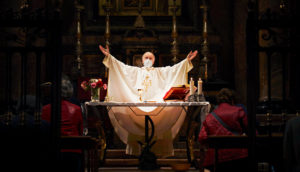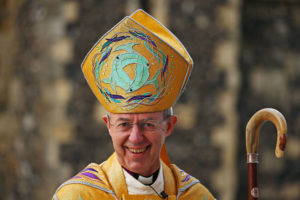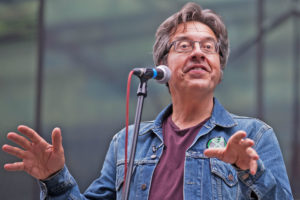Ten years as an inner-city parish priest has not prepared me well for the dilemmas of suburban ministry. Bill showed me round the beautiful graveyard of my new church in Kew. Over the boundary wall, the gentle rhythms of white-flannelled cricket suggest the calming promise of the village idyll. The churchyard is the resting place of several gardening luminaries, as well as the painters Thomas Gainsborough and Johan Zoffany.
But the so-called “Holy Mowers” who maintain this beautiful spot are in something of a quandary about the very purpose of their existence: mowing. After all, this is “No Mow May” — a movement that began in 2019 in Britain and has taken off not just in this country but also in the US. It calls on mowers to give it a rest during the late spring as a way of allowing wildlife to be, well, a little more wild. Plants need pollinators and pollinators needs plants, so let the weeds return. Alas, its detractors think this creates an unholy mess, giving the dreaded green alkanet a free pass during this crucial growing month.
How we came to fall in love with the closely cut grass lawn is a long and fascinating story. Two years after my new church was opened in 1714, the landscape gardener Capability Brown was born. Known as England’s greatest gardener, Brown’s landscapes created the now familiar aesthetic of the English country house — Blenheim, Chatsworth, Burleigh — surrounded by clumps of trees, lakes, and vast swathes of cut lawn as far as they eye could see. Gone were the straight avenues of trees and geometric fountains; the new look was an imagined reconstruction of nature as God intended. Brown was not just copying nature; he was, some said, improving on it.
Styled as unaffected, the Brown look reflected the view that the English had of themselves: free and unmannered. In truth, it was just as mannered and even more expensive to produce than the more obviously artful and rectangular gardens that it replaced. And Marxists were right to point out that all the means of production, the way wealth was generated, was deliberately out of view. It was as though the aristocratic lifestyle could be built upon a few effortlessly grazing sheep. Later gardeners came to regard the Brown revolution as something of a cliché and a bit of a con.
But nonetheless, the idea that a little slice of paradise and individual freedom could be found in cut grass took hold in the most remarkable way. With the invention of the cylinder mower in the 1830s, the cut grass paradise was democratised. Even those moving from the country to the town could have a little patch of their very own Eden. Sport, too — golf, cricket, football — all required a mown surface. And as the British Empire spread its influence around the world, the lawn became a symbol of domestic success and tranquility.
In the US especially, the lawn represented the bourgeoise American Dream, the promise of domestic happiness available to all. It mattered not that the climate was unconducive. Millions of gallons of water were redirected to keeping this promise alive. Fertilisers were invented to keep the weeds down. Hours and hours of maintenance were required. As Yuval Noah Harari said of wheat: it’s not that we domesticated grass, but that grass domesticated us. But No Mow May is something of a fightback. The lawn is being cancelled — not green enough and too imperialistic.
And what all gardeners know, of course, is that the weeds will inherit the earth. This is especially true in Kew churchyard. Among all the fading gravestones, our constant mowing is only a temporary and ultimately futile act of resistance. It’s what we think we ought to be doing as responsible stewards of the natural world. As if the natural world relied upon us for its preservation.
Though perhaps it does. On the other side of the cricket pitch from the church is the Kew Gardens’ Herbarium, containing over seven million dried plants. Kew Gardens also houses the largest collection of living seed and plant diversity on earth: 2.4 billion seeds are carefully stored, frozen or dried — a priceless insurance policy for a future time of ecological crisis. I could not be more aware that it is now science, not religion, that is building Noah’s Ark.
At best, religions are a supporting act, taking our lead from others. The vision of some uniform, Capability Brown-inspired paradise has not helped us. We need different visions of how the natural world and the human aspiration for beauty and order might work together. And I suspect this will mean less carefully managed spaces and more appreciation of the serendipity of the wildflower meadow, with its bees and bugs and butterflies.
After all, a weed is simply a plant growing where it is not wanted. This has a parallel in Mary Douglas’s famous definition of dirt as matter out of place. Mud tramped in from the garden becomes dirt in the kitchen. For Douglas, this idea of everything having a rightful place implies the existence of a kind of social order that is premised upon a map of the world in which everything exists in relation to that map. Religion has generally been very influential in drawing these maps, as Douglas brilliantly explained.
Some maps are more helpful than others, though. The Capability Brown map of the world was profoundly unhelpful and, unfortunately, deeply influential. It set up an impossible view of the natural world and invited us all to participate in its aesthetic and social pretence. It was always a kind of aristocratic deceit. And as a consequence we came to view the real natural world — green alkanet and all — as some sort of uninvited intrusion. Unnatural even. That’s the irony.
No Mow May freaks some people out. Their garden doesn’t look like it should. The dreaded weeds are re-appearing. But what is wrong here is not the weeds, but the way we have come to think about our gardens and our natural spaces. What we need is not fewer weeds but a new map of the natural world and our place within it. We can redesignate them as plants. Learn to make your peace with them. Because when you are six feet under, they will still be growing there above you.
Disclaimer
Some of the posts we share are controversial and we do not necessarily agree with them in the whole extend. Sometimes we agree with the content or part of it but we do not agree with the narration or language. Nevertheless we find them somehow interesting, valuable and/or informative or we share them, because we strongly believe in freedom of speech, free press and journalism. We strongly encourage you to have a critical approach to all the content, do your own research and analysis to build your own opinion.
We would be glad to have your feedback.
Source: UnHerd Read the original article here: https://unherd.com




